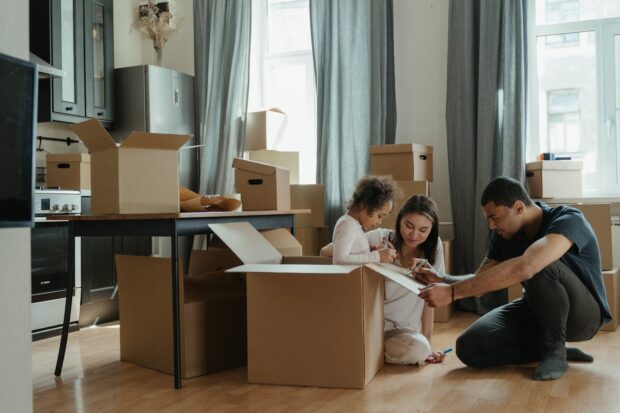Moving into a new home is an ideal time to embrace green living practices. After Deluxe Moving Solutions helps you get your items to your new home, it is advisable to incorporate eco-friendly upgrades that reduce environmental impact and promote sustainability. From energy-efficient appliances to water-saving fixtures and sustainable materials, there are multiple means to create a greener, more environmentally-conscious living space. In this article, we’ll explore essential eco-friendly upgrades and practices for movers looking to adopt a more sustainable lifestyle in their new home.
Energy-Efficient Appliances
 Invest in energy-efficient appliances for your new home, such as ENERGY STAR-certified refrigerators, dishwashers, washing machines, and HVAC systems. These appliances are intended to use less energy while providing maximum performance, resulting in decreased power costs and less carbon emissions. To save the most energy, choose appliances with high energy efficiency ratings and innovative features like programmable settings and smart controls.
Invest in energy-efficient appliances for your new home, such as ENERGY STAR-certified refrigerators, dishwashers, washing machines, and HVAC systems. These appliances are intended to use less energy while providing maximum performance, resulting in decreased power costs and less carbon emissions. To save the most energy, choose appliances with high energy efficiency ratings and innovative features like programmable settings and smart controls.
LED Lighting
Replace standard incandescent light bulbs with energy-saving LEDs throughout your new house. LED bulbs use substantially less energy and last far longer than incandescent lights, lowering both energy usage and the frequency of bulb replacement. Furthermore, LED lights generate less heat, making them safer and more comfortable to use, particularly in confined settings.
Water-Saving Fixtures
Install water-saving fixtures and appliances, such as low-flow faucets, showerheads, and toilets, to conserve water and reduce water usage in your new home. These fixtures are designed to minimize water waste without compromising performance or convenience, helping to lower water bills and alleviate strain on local water resources. Consider upgrading to water-efficient irrigation systems for outdoor landscaping to reduce water consumption further.
Renewable Energy Sources
Investigate alternative energy sources, such as solar panels or wind turbines, to provide sustainable energy for your new house. Solar photovoltaic (PV) systems use sunlight to generate electricity, whereas wind turbines turn wind energy into power. By investing in renewable energy sources, homes may minimize their dependency on fossil fuels, cut carbon emissions, and create excess energy to sell back to the grid.
Energy-Efficient Windows and Insulation
Upgrade windows and insulation in your new home to improve energy efficiency and comfort while lowering heating and cooling costs. Install energy-efficient windows with double or triple-pane glass, low-emissivity coatings, and insulated frames to minimize heat loss and gain. Enhance insulation in walls, floors, and attics with eco-friendly materials such as recycled cellulose or spray foam insulation to prevent air leakage and maintain consistent indoor temperatures.
Recycling and Waste Reduction
Implement a comprehensive recycling and waste reduction program in your new home to minimize landfill waste and promote resource conservation. Set up designated recycling bins for paper, plastic, glass, and metal materials in convenient locations throughout the house. Reduce waste generation by opting for reusable products, composting organic waste, and avoiding single-use plastics and disposable packaging whenever possible.

Sustainable Materials and Finishes
Choose sustainable materials and finishes for home renovation and remodeling projects to minimize environmental impact and promote eco-friendly living. Opt for responsibly sourced, certified wood products, such as bamboo flooring or reclaimed wood furniture, that are harvested using sustainable forestry practices. Select low-VOC (volatile organic compound) paints, stains, and adhesives to improve indoor air quality and lessen harmful emissions.
Sustainable Landscaping
Create a sustainable landscape design for your new home that incorporates native plants, drought-tolerant landscaping, and water-efficient irrigation systems. Native plants require little water, fertilizer, and maintenance compared to exotic species, making them well-suited for sustainable landscaping. Install rainwater harvesting systems or graywater recycling systems to capture and reuse water for irrigation, reducing reliance on potable water sources.
Conclusion
Embracing green living practices and incorporating eco-friendly upgrades in your new home is not only beneficial for the environment but also enhances comfort, lowers utility bills, and promotes overall well-being. By following these essential eco-friendly tips and practices, movers can create a sustainable living space that reflects their commitment to environmental stewardship and contributes to a healthier, more resilient planet for …



 A whistling kettle is the most effective way to speed up your tea or coffee-making process. If you don’t want that, then an electric model will be more efficient than a stovetop one for this purpose. You should always check the speed rating of the kettle you’re buying before making your final decision. If you are an active type of person, a kettle with a high-speed rating will better you. If someone buys an electric or stovetop model designed to provide water at boiling point quickly, it will be able to do so in a much shorter amount of time than the other types.
A whistling kettle is the most effective way to speed up your tea or coffee-making process. If you don’t want that, then an electric model will be more efficient than a stovetop one for this purpose. You should always check the speed rating of the kettle you’re buying before making your final decision. If you are an active type of person, a kettle with a high-speed rating will better you. If someone buys an electric or stovetop model designed to provide water at boiling point quickly, it will be able to do so in a much shorter amount of time than the other types. Kettles come in a variety of shapes and sizes. It is essential to determine what type of size you need before making a purchase decision. Some kettles come with a bottom element only. This is typically an indication that the kettle is not intended to be used for tea but also allows you to boil water very quickly, making it useful in less time-sensitive situations or when convenience trumps taste.
Kettles come in a variety of shapes and sizes. It is essential to determine what type of size you need before making a purchase decision. Some kettles come with a bottom element only. This is typically an indication that the kettle is not intended to be used for tea but also allows you to boil water very quickly, making it useful in less time-sensitive situations or when convenience trumps taste.